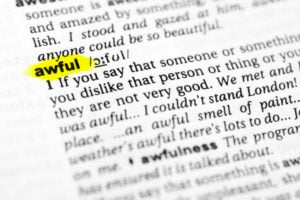Okay, so there’s Shakespeare at the first read-through of “Macbeth”, which he’s revised ten times so there were no typos and it was perfect. Everyone’s reading the script, when one of the actors pipes up with, “Just great, Will, but what’s this ‘bubble, bubble, toil and tribbles’ supposed to mean?”.
Will drops his head in his hands. “It’s a typo,” he moans. Embarrassing things like this never happen to Kit Marlowe.
Typos happen to every writer. Even Marlowe. Even you, no matter how careful you are. The trick is finding them before anyone else does.
Why We Can’t See Our Own Typos — and What to Do About It
You’ll be relieved to know that science has an answer! Psychologist Tom Stafford, who studies typos at the University of Sheffield in the UK, says that writing is a very high-level task. We’re concentrating on the meaning, the message we need to convey, not the mechanical processes like typing. “We don’t catch every detail, we’re not like computers or NSA databases,” he says. We’re actively thinking on a higher level, and typing is a lower-level activity, something that we’re doing almost automatically.
That’s easy to understand. But what about when we’ve finished writing and we’re proofreading? It all boils down to the fact that we see what we expect to see. Again, we’re checking for the meaning of our writing, and how well we’ve conveyed the ideas. We assume that the correct words will be there, so it’s easy to slide right over the typos.
For example, authors writing dialogue use “said” so the reader can tell who’s talking. Readers don’t even consciously register “said” when it’s there, but they can get confused about who’s speaking when it’s not. (Which is why professional authors don’t usually get cute finding new words for “said.”) Readers, who need every word in your work because they’re seeing it for the first time, recognize typos immediately. And, to simplify matters, forget science. You might just not be a great typist. No shame in that, as long as you catch the typos during proofreading.
Preventing Typos
A great way to pick up on your typos is to put the work away for a while, then read it again with fresh eyes. Great in theory, but not so practical when you’re working on a deadline. So let’s discuss some other methods.
- Use your spellchecker only as the first line of defense, but don’t expect it to perform miracles. It can catch obvious misspellings, but when it comes to suggesting words, it can be a source of big laughs, just like autocorrect.
- More practical is taking a short break when you’re finished writing, having a relaxing donut while looking out the window and thinking about life. Or who’s next to die on Game of Thrones. When you go back for a second look at your work, the typos are more likely to stand out.
- Another method is to read your work, concentrating ONLY on the content and meaning. When you’re sure your message is correct and you won’t be distracted by it, read again, this time looking just for typos, nothing else. At this point, it helps to read the work aloud, which slows down your brain and your eyes.
- Read your work backward, starting with the last word on the page. Seriously. The New York Times recommends this.
- Ask someone else to read the work. As they haven’t seen it before, it’s easier for them to spot typos. No second reader? Try text-to-speech software. As the software reads to you, follow along with a hard copy.
- Stafford recommends making the work look as unfamiliar as possible. Change the background color or font color, use another font, or print it out and make your corrections by hand. Lots of people say that they can see errors on printouts quicker than they see them onscreen.
Typos can plague even the greatest of us. As Mark Twain said, “In the first place God made idiots… then He made proof-readers”.



